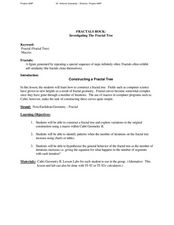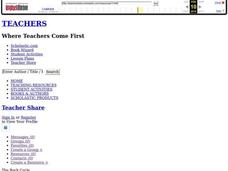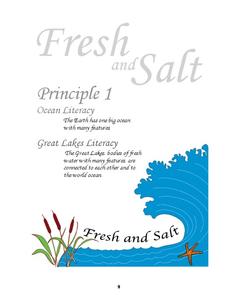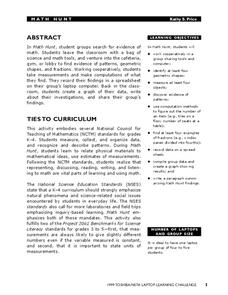Curated OER
Polar Bear, Polar Bear, What Do You Hear? Lesson Plan
Students use technology and listening skills to explore the sounds of their environment. In this environment observation lesson, students read Polar Bear, Polar Bear, What Do You Hear? in order to identify the sounds in the story; these...
Curated OER
Earthquakes
Students observe the melting of ice. In this phase change lesson, students observe ice as it melts. They discuss the process and create a Venn diagram comparing water and ice.
Curated OER
Fractals Rock
Students identify the repeated sequences of a pattern. In this geometry lesson, students identify fractals in patterns and nature. They construct a fractal tree and make conjectures.
Curated OER
The Rock Cycle
Students explore the concept of the rock cycle. In this geology lesson plan, students identify, classify, and observe three different types of rocks. Students then list and char the characteristics of their rocks.
Curated OER
A Canadian Inventory: The Way We Are!
Students, in groups, explore major thematic sections of the Atlas of Canada. They use their findings to produce a wall display, consider and incorporate the issue of sustainability into their material and deliver a presentation to the...
Curated OER
May The Force Be With You
Eighth graders investigate Newton's Laws of Motion. They use the example of a roller coaster for illustration purposes. A force associated with a roller coaster is tested, data graphed, and a conclusion is drawn. They use excel in order...
Curated OER
The Right Chemistry
Students see that chemistry is the study of matter, how matter reacts and combines to create new chemicals, the changes that take place in matter and what makes up matter. This lesson plan provides many good ideas across the curriculum...
Curated OER
The Miracle Fish: Learning to Design an Experiment
Learners develop procedures to explore the behavior of fish. In this scientific experiment lesson students from a hypothesis, write a question, identify different variables and controls in their experiment.
Curated OER
The Greenhouse Effect
Seventh graders investigate the temperature change in open and closed containers. In this earth science instructional activity, 7th graders relate this lab activity to greenhouse effect. They create a line graph from data collected in...
Curated OER
Graphing Sunspot Cycles
Students explore sunspots and then graph them to analyze the data. In this sunspot cycles lesson students complete an activity sheet and complete questions.
Curated OER
Solar System: The Four Inner Planets and Earth's Moon and Astronauts
Second graders read THe Magic School Bus: Lost in the Solar System. In this language arts and science lesson, 2nd graders explore the four inner planets. Students view the inner planets using Google Earth.
Curated OER
Carson McCullers: Loneliness and Frustrated Love
Pupils examine the themes of loneliness and frustrated love in the work of Carson McCullers. In this theme analysis instructional activity, students complete a comparison of patterns in the novels of McCullers as a part of a theme analysis.
Curated OER
Jumpy Dolls
Students are challenged to design and construct a jointed figure that moves in a motion something like jumping jacks when a string is pulled.
Curated OER
Dating Sedimentary Strata
Students investigate how the age of sedimentary strata is determined. In this sedimentary strata lesson, students work through problems that show that geological history covers millions of years. They distinguish between relative and...
Curated OER
Some Similarities Between the Spread of an Infectious Disease and Population Growth
Learners compare and contrast the spread of infectious diseases and population growth. In this biology lesson plan, students identify the exponential growth pattern of spreading diseases. They relate this to HIV infection and AIDS.
Curated OER
The ABC's of Walter Anderson
Fifth graders examine how motifs, symbols, and ideas influence various pieces of visual art. They compare and contrast the work of Walter Anderson to pre-historic cave paintings and create a glue line print using motifs and symbols found...
Curated OER
Volcano Contour Models Activity
Students experiment with water levels and plastic topographic volcano models to determine the contour lines that would be used to create a topograpohic map of a volcano. They use the traced lines to actually develop the map.
Curated OER
A Model of the Sea-floor
Students create a paper model to illustrate sea-floor spreading.
Centers for Ocean Sciences
Ocean and Great Lakes Literacy: Principle 1
Is your current lesson plan for salt and freshwater literacy leaving you high and dry? If so, dive into part one of a seven-part series that explores the physical features of Earth's salt and freshwater sources. Junior hydrologists...
PHET
CME Plotting
Young scientists build on their previous knowledge and apply it to coronal mass ejections. By plotting the path of two different coronal mass ejections, they develop an understanding of why most don't collide with Earth.
Curated OER
Math Hunt
Go on a scavenger hunt around your school to find evidence of math. Investigate different areas of your school for patterns, fractions, and different geometric shapes. Finally, create a spreadsheet and plot the data you've collected.
Curated OER
Water Cycle
Identify and interpret the earth's different water sources. Third and fourth graders describe and demonstrate the process of the water cycle, make a model of its two main parts, and predict and infer to answer questions about the model.
Teach Engineering
Automatic Floor Cleaner Computer Program Challenge
Have your class use the engineering design process to program a vacuum robot. Using computer engineering concepts, teams program an automatic floor cleaner to traverse designated patterns.
Discovery Education
How's the Weather?
Young meteorologists explore different aspects of the weather while learning about measurement devices. They build instruments and then set up a weather station outside and measure temperature, humidity, air pressure, wind speed, and...

























